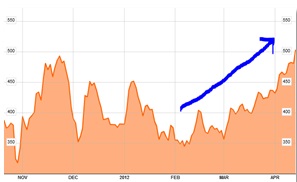Despite all of its best hopes, Wall Street will never escape what's happening in the Eurozone.
The 1 trillion euro ($1.3 trillion) slush fund created to keep the chaos at bay is not big enough. And it never was.
Spanish banks are now up to their proverbial eyeballs in debt and the austerity everybody thinks is working so great in Greece will eventually push Spain over the edge.
Spanish unemployment is already at 23% and climbing while the official Spanish government projections call for an economic contraction of 1.7% this year. Spain appears to be falling into its second recession in three years.
I'm not trying to ruin your day with this. But ignore what is going on in Spain at your own risk.
Or else you could go buy a bridge from the parade of Spanish officials being trotted out to assure the world that the markets somehow have it all wrong.
But the truth is they don't.
EU banks are more vulnerable now than they were at the beginning of this crisis and risks are tremendously concentrated rather than diffused.
You will hear more about this in the weeks to come as the mainstream media begins to focus on what I am sharing with you today.
The Tyranny of Numbers in the Eurozone
Here is the cold hard truth about the Eurozone.
European banks reportedly will have more than 600 billion euros ($787 billion) in redemptions by the end of the year. They come at a time when the banks have sustained billions in capital losses they can't make up.
Worse, they've borrowed a staggering 316.3 billion euros ($414.9 billion) from the ECB through March, which is 86% more than the 169.8 billion euros ($222.7 billion) they borrowed in February. This accounts for 28% of total EU-area borrowings from the EU, according to the ECB.
There will undoubtedly be more borrowing and more losses ahead as interest rates rise further.
The process will not be pleasant:
- Credit default swap costs will rise, pushing debt yields to new highs while at the same time making fresh Spanish debt cost-prohibitive;
- The Spanish government will force national banks to buy debt at higher rates, triggering capital losses on their bonds;
- Those same losses will trigger margin calls, forcing banks to unload segments of their debt and equity portfolios;
- Rinse and repeat steps 1-3 until there is no more money, the public revolts, the EU splinters, or all three.
Unfortunately, this vicious cycle is already under way.
The Big Boys Go on the Offensive
On Monday, Spanish 10-year bond yields pushed up to 6.07%. (Yields and prices go in opposite directions. If one is rising, the other is falling.) They relaxed slightly on Tuesday, but...
At the same time, Spanish credit default swaps touched record levels, reaching 502.46 basis points according to Bloomberg News. That process actually began in February when traders starting upping the ante on Spanish debt.

Figure 1: Source: Bloomberg.com - CSPA1U5: IND
Credit default swaps pay the buyer face value if the borrower - in this instance Spain - fails to meet its obligations, less the value of the defaulted debt. They're priced in basis points. A basis point equals $1,000 on each $10 million in debt.
Wall Street sells them as insurance against default.
In reality though, they are like buying fire insurance on your neighbor's house in that you now have an incentive to burn it down.
Let me briefly explain how the playbook works.
The big boys are going on the offensive and pushing the cost of insuring Spanish debt to new highs because they know that the Spanish government prefers more bailouts to pain. It's the same thing they did with Greece, Ireland and Italy.
At the same time, they're shorting Spanish debt knowing full well that there will be massive capital losses as Spanish bonds deteriorate.
What these fiscal pirates are counting on is the ECB and Spanish government riding to the rescue.
At that point, they will sell their swaps and go long Spanish bonds, thus netting themselves a two-fer.
How to Play the Eurozone Crisis
This could be a good thing for savvy individual investors-- at least temporarily.
The markets have become addicted to bad news. We cheer when central bankers step in with quantitative easing, conveniently forgetting things are so terrible we "need" it in the first place.
We'd rather take one more "hit" than step away from the narcotics of cheap money.
That's why I expect a rally when the ECB is forced to step in no later than Q3 2012.
Here's what to do ahead of time:
- Buy volatility when it's low. My favorite choices are either call options on the VIX or the iPath S&P 500 VIX Short Term Futures ETN (NYSE: VXX), an exchange-traded note that effectively tracks the VIX. This will help you capture the initial downturn while also taking the sting out of your broader portfolio. At 18.85 the VIX is not as low as I'd like to see it, but not a bad entry point, either. If the VIX drops to 12-15, that's the time to be very interested in this trade.
- Sharpen your pencils and pick up shares of large "glocal" companies when they get put on sale in the months ahead. Many will actually use the downdraft to solidify their competitive positions and be stronger on the other side.
- Gold and silver are going to get whacked. This is not a problem for those with a longer term perspective - both metals are likely to be sharply higher in the years ahead. However, in the shorter term, gold is likely to trade down sharply as banks raise cash. I'll be looking to $1,500 or so as line in the sand. Silver's retracement will be more nuanced because it is a function of the perceived drop in industrial usage that will accompany an EU disintegration. In that sense it won't be as deep or probably as steep. I see $20-22 as a very attractive price.
- Short the euro. Go long German Bund futures and bonds. According to Bloomberg, the June 10-year bund futures contract is 140.43, or slightly below the record 140.51 it hit recently.
- Buy U.S. dollars. Longer term, they still stink but the world will run to them once again when the stuff hits the fan.
At the end of the day, thinking about all this is no fun. I know - I get paid to do it every day. When the fundamental environment is such a wreck, it can wear on you. It certainly does on me.
But you know what?
That's not actually so bad, because big down days are actually profits in the making; it's how you deal with them that makes the difference.
Related Articles and News:
- Money Morning:
Stock Market Volatility: How to Beat the Market at its Own Game - Money Morning
Is Groupon (Nasdaq: GRPN) the Next Enron? - Money Morning:
Five Savvy Ways to Conquer the Wall of Worry - Money Morning:
Five Ways to Make 2012 Your Best Year Ever
[epom]
About the Author
Keith is a seasoned market analyst and professional trader with more than 37 years of global experience. He is one of very few experts to correctly see both the dot.bomb crisis and the ongoing financial crisis coming ahead of time - and one of even fewer to help millions of investors around the world successfully navigate them both. Forbes hailed him as a "Market Visionary." He is a regular on FOX Business News and Yahoo! Finance, and his observations have been featured in Bloomberg, The Wall Street Journal, WIRED, and MarketWatch. Keith previously led The Money Map Report, Money Map's flagship newsletter, as Chief Investment Strategist, from 20007 to 2020. Keith holds a BS in management and finance from Skidmore College and an MS in international finance (with a focus on Japanese business science) from Chaminade University. He regularly travels the world in search of investment opportunities others don't yet see or understand.



